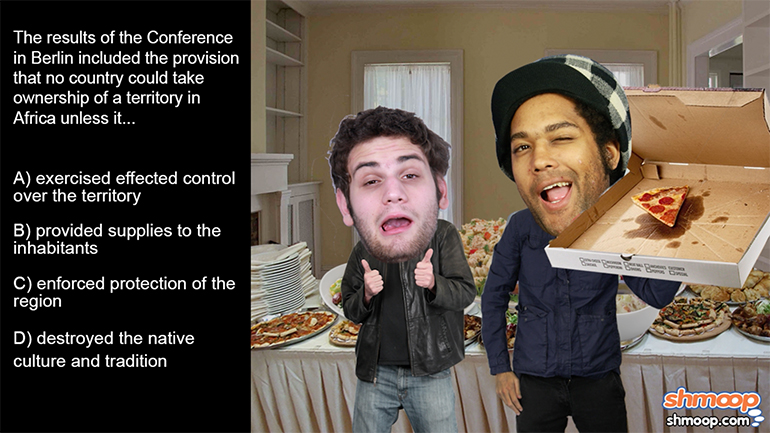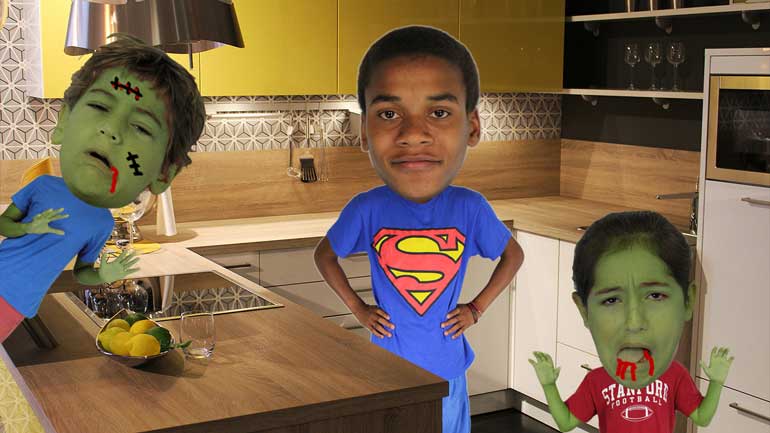ShmoopTube
Where Monty Python meets your 10th grade teacher.
Search Thousands of Shmoop Videos
AP European History Videos 26 videos
AP World History 4.3 Industrialization and Global Integration, c. 1750 to c. 1900. What was the immediate cause of the First Sino-Japanese War?
AP World History 3.2 Industrialization and Global Integration, c. 1750 to c. 1900. The Sepoy Mutiny resulted in...what?
AP World History 3.1 Industrialization and Global Integration, c. 1750 to c. 1900. The 1869 construction of which important canal drastically chang...
AP European History 2.1 Period 1: 1450-1648 286 Views
Share It!
Description:
AP European History Period 1: 1450-1648 Drill 2, Problem 1. As a result of the meeting in the image, which of the following occurred?
Transcript
- 00:04
And here's your shmoop du jour brought to you by the diet of
- 00:06
worms it's what campers resort to when we get really really hungry take a look [Camper with a huge pile of worms]
- 00:12
at the image right there and here's today's question as a result of the
- 00:15
meeting illustrated in the image which of the following occurred and here your
- 00:19
potential answers [mumbling] well yes this meeting was in fact called the diet of
Full Transcript
- 00:27
worms we know what you're thinking but the meeting did not take place in a pile [people stuck in a pile of dirt]
- 00:32
of dirt actually a diet refers to a deliberate assembly and worms is a city
- 00:38
in Germany really we're not making this stuff up people funny name for a [Worms shown on a map of Germany]
- 00:41
historically significant meeting yes something you want to think about when
- 00:45
you're eating spaghetti probably not well to best answer the question we [children running away from a meal of spaghetti]
- 00:49
should probably figure out what the point of the meeting was in the first
- 00:51
place well basically Pope Leo the tenth had recently read Luther's ninety-five
- 00:57
theses and not so surprisingly given the subject matter found a teensy-weensy few [Pope Leo reading a theses and throws book in the air]
- 01:02
little problems with it 41 problems to be precise and when the Pope has 41
- 01:07
problems with your ninety-five theses well you might want to go back to the
- 01:11
drawing board and so the whole meeting thing served as a place for Luther to [People congregating at a meeting]
- 01:15
renounce his writings to the Pope. Well that was Leo's plan anyway but spoiler
- 01:19
alert Luther showed up and did the exact opposite awkward even more awkward was [Pope soeaking to the Pope]
- 01:25
that many people of the meeting actually fell for that pile of worms allowing for
- 01:29
the idea to spread throughout Europe and even in the New World well, eliminates B
- 01:33
and D and following the meeting Martin Luther not related to King jr.
- 01:37
translated the New Testament into his native tongue German not Italian so that [Luther translating the new testament]
- 01:43
eliminates C as well. The members have stated the meeting were so impressed by
- 01:47
Luther's defense of his writings that they began to support him more and more [People waving their arms in support]
- 01:51
and hey, the thought of gaining ownership over the church's land didn't hurt
- 01:55
either religious reform became a hot-button issue of the state making A A button labelled hot]
- 01:59
the correct answer and making this meeting one of the biggest and most
- 02:03
uncomfortable backfires in human history yea yikes!
Related Videos
AP European History Period 3: 1815-1914 Drill 2, Period 1, Les Demoiselles d'Avignon represented the beginning of which of the following art m...
AP European History Period 3: 1815-1914 Drill 2, Problem 4. Paintings like the one depicted above were a direct reflection of what?
AP European History 1.2 Period 4: 1914-Present Not long before this picture was taken, Hitler rose to power and ruled by decree alone due to which...
AP European History 1.4 Period 3: 1815-1914. As evidenced through the passage above, Karl Marx was a passionate leader and is considered the father...
AP European History 1.1 Period 4: 1914-Present. A person who supported actions such as the one shown in the image would have supported The Final So...

























